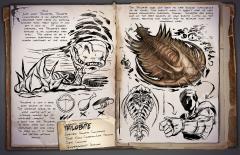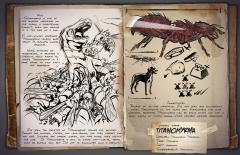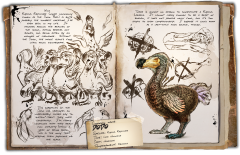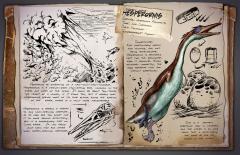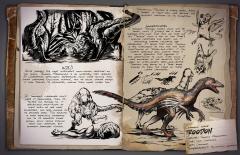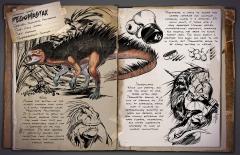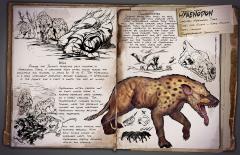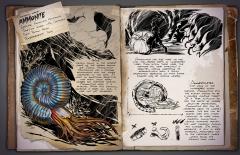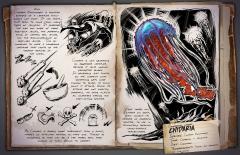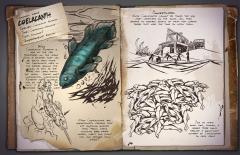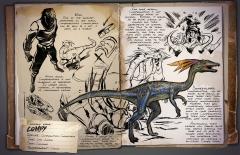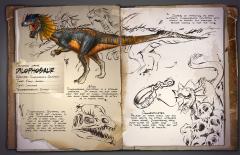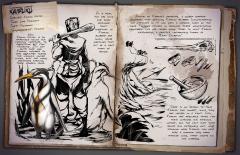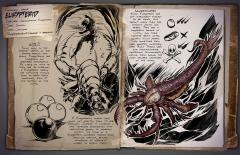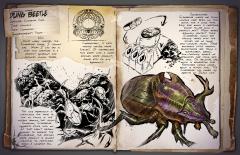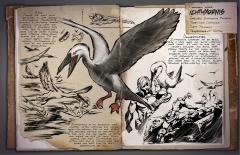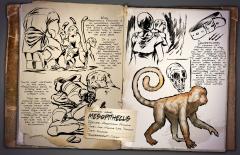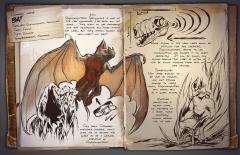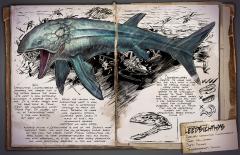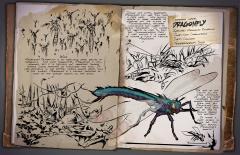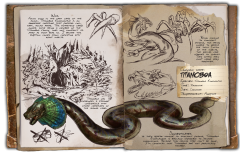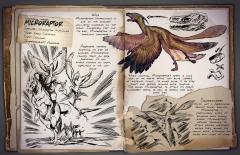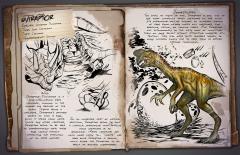Search the Community
Showing results for tags 'not rideable'.
-
From the album: Dossiers
Common Name: Trilobite Species: Trilobite Conchadurus Time: Early Cambrian-Late Permian Diet: Carnivore Temperament: Defensive Wild: Like most Trilobites, Trilobite Conchadurus is an opportunistic carnivore that feeds on anything smaller than itself which it can get a hold of. A sluggish creature, the Trilobite's best defense is its incredibly hard shell. This seems to be a common adaption for the slower creatures of the island. Trilobite is not a very good source of food. The creature seems to be made mostly out of internal organs and its defensive carapace. This is good for the Trilobite, as both river and ocean predators are less likely to prey on it if there are better options around. Domesticated: The Trilobite does not seem to have enough intelligence to be tamed. This doesn't mean it doesn't have its uses among resourceful survivors, though. Trilobites are easily one of the best sources of high quality chitin on the island, assuming one doesn't wish to venture into the dangerous caves. Known Information: Trilobite is not a very good source of food. The creature seems to be made mostly out of internal organs and its defensive Carapace. This is good for the Trilobite, as both river and ocean predators are less likely to prey on it if there are better options around. -
From the album: Dossiers
Common Name: Titanomyrma Species: Titanomyrma parvagigan Time: Paleogene Diet: Herbivore Temperament: Territorial Wild: Titanomyrma is one of the smaller creatures on the island; A frightening thought, when you realize it is the size of a dog. A hive-minded herbivore, Titanomyrma usually goes about it's business unless provoked. When attacked or threatened, it releases a chemical which alerts all Titanomyrma in a large range to help fight the aggressor. I've seen two varieties of Titanomyrma: Drones and soldiers. Drones are smaller, faster and land-bound, and they harvest for the hive. Soldiers are larger, slower and have wings; They defend the hive. If Titanomyrma is akin to other hive-insects, there must be Queens too, but I've yet to encounter such a variant. Domesticated: Because of its hive mentality, I've not seen any successfully tamed Titanomyrma on the island yet. Fortunately for lone survivors, separated Titanomyrma can be easily picked off for a small supply of Chitin among other valuable natural resources.- 1 comment
-
- titanomyrma
- ant
- (and 7 more)
-
From the album: Dossiers
Common Name: Dodo Species: Raphus replicare Time: Late Holocene Diet: Herbivore Temperament: Oblivious Wild: Raphus replicare (more commonly known as the Dodo Bird) is quite possibly the dumbest creature I've ever seen in my life. It wanders around the beaches of the island, eating berries off bushes and being eaten by all manner of carnivore. Without the Dodo the whole Island's food chain would disintegrate. This subspecies of the Dodo has developed an unbelievably clever way to sustain itself: they mate constantly. I'm fairly convinced that they reach full maturity within a week of being born. This is the only trait keeping them populous on the island. Domesticated: There is almost no reason to domesticate a Raphus replicare. It cannot carry enough to be a beast of burden, it does not provide much food, and it's too stupid to show companionship. I suppose it could work as a last-ditch food source, though. -
From the album: Dossiers
Common Name: Hesperornis Species: Hesperornis Avenatantes Time: Late Cretaceous Diet: Piscivore Temperament: Flippant Wild: Appearing as something of a half-duck-half-dinosaur, Hesperornis is a medium-sized fish-eating bird, common in the rivers and lakes os the island. It would be about two-thirds the height of a human, if it stood tall, but it rarely does. Hesperornis spends most of its time gliding along the surface of the water, where it is much more maneuverable. Hesperornis is barely a threat to any land-dwelling creature, as its legs are too short for it to move around effectively, but it is a surprisingly fast on the water. It can easily hunt down fish and other small water-dwelling creatures. Domesticated: Not particularly useful for hunting, and not being affectionate, Hesperornis is primarily kept for the specialized eggs it produces. When rendered correctly, the eggs separate into two distinct substances: One is a protein substance high in calories, and the other is an oily liquid that is effectively the same as the oil found in the ocean!- 1 comment
-
- hesperornis
- flippant
-
(and 6 more)
Tagged with:
-
From the album: Dossiers
Common Name: Troodon Species: Troodon Magnanimus Time: Late Cretaceous Diet: Carnivore Temperament: Nocturnally Aggressive Wild: Quite possibly the most intelligent non-human creature on the island, Troodon Magnanimus is an incredibly fast learner. It understands meaningful experiences much more quickly than other creatures (including humans), and its social nature means it also teaches its pack mates, making them more clever too. If Troodon’s cleverness didn’t make it formidable, than its tactics and biology do. It specifically pack-hunts at night when we are most vulnerable, and sees humans as its primary prey. This audacity is made especially dangerous due to its serrated fangs’ poison, which drains stamina from any creature, but outright paralyses humans. Thankfully, Troodon is fairly small. Were it larger, it might well have become the dominant creature of its ecosystem. Domesticated: I thought Troodon simply could not be tamed, until I finally saw a lone survivor with one. She told me that she let “Troody” hunt a few of her tribe’s smaller creatures for sport, and it eventually started following her everywhere. It seems that while Troodon is too intelligent to fall for the rote conditioning of ‘tranq-and-feed’, it can instead gradually gain loyalty from a social approach that provides it the opportunity to hunt. Ever since, I have wondered at the benefits that a pack of ultra-smart, bred-for-battle Troodon may bring to a tribe brave enough to earn the favor of these clever carnivores.- 1 comment
-
- nocturnally aggressive
- late cretaceous
- (and 5 more)
-
From the album: Dossiers
Common Name: Pegomastax Species: Pegomastax Fructarator Time: Early Jurassic Diet: Herbivore Temperament: Defensive Wild: Among the bottom of the island’s dinosaur food chain is a small herbivore called Pegomastax Fructarator. It is content to spend all day alone, gorging itself on far more food that you might reasonably expect for a creature of its tiny stature. It’s beak appears perfectly evolved for collecting food from plants while avoiding the indigestible fibrous strands. Pegomastax is likely to ignore any nearby creature and continue foraging, unless it is attacked. At which point, it turns into a very aggressive (though rather nonthreatening) opponent, shrieking and wooping far above it’s actual threat level. You would expect a creature this small and weak to live in flocks, but Pegomastax seems to be fairly solitary in nature. Domesticated: While not pretty, and far too small to ride, tribes often keep Pegomastax around as a kind of farming aid. It’s skill at scavenging means that it collects an extraordinary quantity of seeds and berries, while also handily gathering the rare flowers, mushrooms, and other ingredients necessary to cool up unusual conceptions.- 1 comment
-
- pegomastax
- defensive
- (and 8 more)
-
From the album: Dossiers
Common Name: Hyaenodon Species: Hyaenodon Dirus Time: Late Eocene – Early Miocene Diet: Carnivore Temperament: Opportunistic Wild: Among the Island’s tenacious pack hunters is Hyaenodon Dirus, a carnivore most often found across the mountains and tundras, in packs of 3 to 5. The Hyaenodon is a very intelligent predator: before engaging, it determines if the payoff for a fight is worth the risk of injury. Hyaenodon often prefer not to fight unless there is already weakened prey nearby, or a fresh carcass. This temperament changes quickly, thought, near the presence of injured or dying creatures. Hyaenodon quickly becomes very aggressive, and the pack attacks with ruthless abandon. With each vicious chomp of scavenged meat, the Hyaenodon rapidly recovers health and stamina. Domesticated: Despite being too small to ride, Hyaenodon are still popular pets. Their intelligence means they train well, and their natural pack strength makes them excellent hunting dogs. Their capability to quickly recover health by consuming raw flesh off the bone ensures they can take much punishment and yet continue fighting. A common (and terrifying) sight on the tundra is a rider on a canis with a pack of Hyaenodon at it’s side, howls and jeers echoing through the night.-
- hyaenodon
- opportunistic
- (and 6 more)
-
From the album: Dossiers
Common Name: Ammonite Species: Ammonitina Multiamicus Time: Late Jurassic - Mid Cretaceous Diet: Bottom Feeder Temperament: Passive Wild: Usually found in the deepest parts of the waters around the island, Ammonitina Multiamicus has a strange relationship with the other creatures of the deep. It must do something beneficial for them, since every nearby sea creature defends Ammonitina when it is attacked. What this distinct symbiosis is based on, alas, I have not yet discovered. Ammonitina has also made its way into the deeper parts of underwater caves. Even within these caves, the creature will draw attention if assaulted, making harvesting its resource-rich shell a tricky proposition depending on what other dangers may be lurking nearby. Domesticated: Like many of the untamable ocean dwellers, Ammonitina still has enough utility to be a valuable hunting target. If a tribe is willing to risk the wrath of nearby would-be protectors, Ammonitina bile can be harvested from it’s corpse’s innards. This bile can be worked over with other chemicals to make many powerful concoctions, usually antidotes against the most powerful poisons and illnesses. Its shell meanwhile, is rich in rare materials, presumably due to the creature’s unique place along the Island’s food chain.-
- ammonite
- late jurassic
- (and 6 more)
-
From the album: Dossiers
Common Name: Cnidaria Species: Cnidaria omnimorph Time: Cambrian - Holocene Diet: Carnivore Temperament: Passive, but aggressive at close range Wild: Cnidaria omnimorph is another example of a creature which should not exist. It has traits that seem to come from many types of jellyfish. It possesses the size and shape of large egg-yolk jellies, the powerful sting of certain box jellies, and the bioluminescence of deep-sea jellies. This all combines to make a dangerous creature that lights up the deepest reaches of the ocean. Cnidaria is not generally an aggressive creature, because it lacks normal perceptive senses. it generally just floats on the current until something gets close enough to sense, at which point it attacks. While its attacks are not directly powerful, its sting injects an incredibly strong and fast-acting sedative. Most tribes kill Cnidaria on sight, then collect its reserve of powerful sedative, to use in technically advanced long-distance tranquilizers. Domesticated: As Cnidaria is barely more intelligent than a plant, there's no effective method to tame one. though dangerous as they can be, a few tribes even keep schools of them around to harvest.-
- cnidaria
- not tameable
- (and 8 more)
-
From the album: Dossiers
Common Name: Coelacanth Species: Coelacanth nutritia Time: Cretaceous-Holocene Diet: Omnivore Temperament: Reactive Wild: Coelacanth nutritia is one of the few creatures on the island with a relative that can be found back home. The Coelacanth lives in the waters around the island, as well as the rivers and lakes within the island. Unlike most Coelacanth, Coelacanth nutritia meat contains less oil and urea. In fact, it is one of the healthier sources of meat on the island. Most Coelacanths are opportunistic feeders that eat anything smaller that itself, likely including baby water snakes, insect and plant life, and perhaps each other? Domesticated: While Coelacanths cannot be tamed the way most creatures on the island can, they provide a possible source of meat for coastal tribes that have the time to catch them.-
- coelacanth
- coel
-
(and 4 more)
Tagged with:
-
From the album: Dossiers
Common Name: Compy Species: Compognathus curiosicarius Time: Late Jurassic Period Diet: Carnivore Temperament: Curious Wild: One of the smallest predators on the island, Compognathus curiosicarius can be seen as a pet, a pest or a threat. While alone, Compsognathus is not dangerous or aggressive. In larger packs, however, it remembers its carnivorous nature. After a group of Compsognathus grows to a certain size, their pack mentality always seems to embolden them to "attack". For some reason Compsognathus is not naturally afraid of humans. Rather it seems to be quite curious of humans and their instruments of survival. They tend to be drawn toward humans out of this curiosity, and then call their pack mates to help explore their discovery. This usually leads to the aforementioned pack aggression. Domesticated: Compsognathus's can be tamed quite easily, so some tribes keep them for little more than friendly companionship. However they gain increasing significant attack power and speed when close proximity to other Compsognathus, as their pack aggression takes over their behavior. Additionally their distress call carries quite far, rapidly alerting the tribe and its pets to danger more efficiently, and increasing the likelihood of forming a so called 'Compy Gang'.-
- compsognathus
- compy
- (and 7 more)
-
From the album: Dossiers
Common Name: Dilophosaur Species: Dilophosaurus sputatrix Time: Early Jurassic Diet: Carnivore Temperament: Skittish Wild: Dilophosaurus sputatrix is a strange creature. It stands at just over half the size of known Dilophosaurs, and runs from aggressors as often as it fights them. Dilophosaurus sputatrix has a few traits not common in the Dilophosaurus genus. It has a very shrill call, and a decorative ridge of skin on its neck. I believe these are used to attract mates, as well as intimidate prey and would-be predators. Instead of attacking its prey outright, Dilophosaurus sputatrix spits venom to weaken and paralyze it before moving in for the kill. Domesticated: Because of their shrill cry and their ability to attack intruders from range, Dilophosaurus seem most suited as "guard dogs". Due to their small size, they are not suitable as mounts.-
- dilophosaur
- dilo
-
(and 8 more)
Tagged with:
-
From the album: Dossiers
Common Name: Kairuku Species: Kairuku waitaki Time: Late Paleogene Diet: Piscivore Temperament: Friendly Wild: Kairuku Waitaki is an amazingly docile and friendly creature, to everything but fish. Honestly, I'm not quite sure how Kairuku manages to stay populated across the islands colder climates, with the many predators stalking these frozen lands. It is weak, and only one small defensive trait: suspended in Kairuku blubber are small, dense particles that act as a light form of armor. Adding to Kairuku's problems, a clever survivor discovered that refining Kairuku blubber (concentrating the particles in it) can yield a natural form of the same Polymer utilized in advanced tribes' manufacturing processes. This has caused many tribes to hunt Kairuku extensively, a practice colloquially known as "Kairu Clubbing". Domesticated: There is no reason to tame Kairuku for combat since they are useless in a fight. Still, Kairuku are regularly tamed for their cuteness and friendly nature, and the fact that their bodies run extremely hot. Just standing near Kairuku can help keep a survivor stay warm through long, harsh nights on the icebergs.-
- penguin clubbing
- organic polymer
- (and 10 more)
-
From the album: Dossiers
Common Name: Dimetrodon Species: Dimetrodon calorector Time: Early Permian Diet: Carnivore Temperament: Reactive Wild: Dimetrodon Calorector is a much calmer predator than most on the island. Because it lives off smaller prey than humans, it generally ignores anything much larger than a Coelacanth. Dimetrodon is one of the few carnivores on the island that could be classified as reasonably friendly in the wild. The sail on Dimetrodon's back is a fascinating thing. It can be angled to provide shade from the sun, and allows Dimetrodon to disperse heat more quickly. The inner workings of the sail can also restrict blood flow in the creature to hold in excessive heat. Together, these two traits allow Dimetrodon to comfortably survive in any climate, though they are most commonly found in the swamplands which are rich in prey. Domesticated: If Dimetrodon was a bit larger, or didn't have that massive sail, it would make a decent mount. However, its main use to survivors is to utilize the sail's insulating capabilities. Just being near a Dimetrodon gives excellent protection from the heat and the cold, which has saved my life through more than one ice blizzard in the frozen mountains!-
- dimetrodon
- tameable
- (and 7 more)
-
From the album: Dossiers
Common Name: Dimorphodon Species: Dimorphodon equesica Time: Early Jurassic Diet: Carnivore Temperament: Reactive Wild: Dimorphodon Equesica is another of the island's Jekyll-and-Hyde creatures. It is normally passive, sometimes even friendly. When provoked, it becomes very aggressive, even against larger creatures it has no business fighting... often to its own fatal end. Dimorphodon can make short work of smaller opponents, however, due to its large (but lightweight) skull and teeth. Barely a meter tall, Dimorphodon should be low on the food chain, but its incredible speed and surprisingly strong bite makes it fairly dangerous, especially en masse as they tend to attack in groups. A flock of angry or hungry Dimorphodon can take down prey several times their size, so survivors should take care not to hunt near where a flock is gathered. Domesticated: Dimorphodon is one of the creatures on the island that is easily domesticated for companionship. But its use in combat is also quite clear: it will hunt in large groups to seek out enemy dino riders directly, harassing them to no end—regardless of the might of the mount upon they may be astride!-
- dimorphodon
- dimo
- (and 8 more)
-
From the album: Dossiers
Common Name: Eurypterid Species: Jaekelopterus Euryperus Time: Silurian Diet: Carnivore Temperament: Aggressive if approached Wild: Found only in the deepest depths of the waters around the island, Eurypterids are dangerous and adaptable Arthropods. As likely to hunt as they are to scavenge, a Eurypterid rarely has difficulty finding food to keep itself nourished, even at the bottom of the ocean. A Eurypterid’s threat does comes not directly from its raw strength. Instead, it combines a hard defensive exoskeleton with debilitating poison to powerful effect. The sting of a Eurypterid increases torpor while reducing stamina, quickly rendering its opponent unable to defend itself. Domesticated: While Eurypterid are not intelligent enough to be tamed, this doesn't mean they are without utility for tribes. They are a wonderful source of Chitin, and their digestive tract often contain Silica Pearls. They sometimes even have incredibly rare Black Pearls used for manufacturing mysterious technologies, making them among the most valuable creatures on the island.-
- eurypterid
- invertebrate
- (and 7 more)
-
From the album: Dossiers
Common Name: Dung Beetle Species: Scarabidae Gigas Time: Holocene Diet: Coprophagic Temperament: Passive Wild: What magic created the Scarabidae Gigas, I cannot say. What I can say is that this creature is a perfect symbiont for advanced human tribes. Coprophagic, it eats mostly useless waste (feces). It metabolizes this waste into a more refined waste product, along with an oily byproduct. The oily byproduct is chemically the same as the oil found in the oceans around the island. Somehow, Scarabidae converts feces into oil. If that wasn't reason enough to worship the Scarabidae, the refined waste product is almost identical to fertilizer from a compost bin. Domesticated: Scarabidae makes me think humans have been on the island for a long time. Why else would a creature evolve to be such a perfect pet? Most tribes jealously protect their scarabidae, whom are handily tamed with the skilled use of some well-handled feces. These wondrous little organic biofactories are truly a sustainable, green, eco-friendly source of resources for living off the land. Oil becomes gas, which is generator fuel. Fertilizer means crops, which is human fuel. The scarabidae can power all aspects of island life!-
- dung beetle
- bug
-
(and 8 more)
Tagged with:
-
From the album: Dossiers
Common Name: Ichthyornis Species: Ichthyornis piscoquus Time: Late Cretaceous Diet: Piscivore Temperament: Skittish Wild: Among the most vocal creatures on the island, Ichthyornis Piscoquus is actually a relatively normal seagull. Living near the beaches, it primarily eats fish, and its distinctive cries can be heard echoing over literally every beach across the island. As you might expect from a seagull, Ichthyornis will flee at the slightest provocation. Ichthyornis is an excellent fish hunter, often catching and killing small-to-medium fish in one attack. Its primary method of predation is to dive into the top layers of water and impale or bite its prey. When looking for fish,Ichthyornis will often just fly in circles over the water and wait for its next opportunity to dine. Domesticated: Ichthyornis surprised me by being a very loyal and social creature, once tamed. It likes to ride on its owner's shoulder, and bring that person treats (in the form of fish, of course) which its beak-grip enhances with extra healing vitamins. The personality of Ichthyornis reminds me of a housecat hauling a dead lizard back to its family, except bringing extra-healthy fish instead.-
- ichthyornis
- bird
- (and 7 more)
-
From the album: Dossiers
Common Name: Mesopithecus Species: Mesopithecus amicufur Time: Late Miocene/Late Pliocene Diet: Omnivore Temperament: Curious Wild: Mesopithecus amicufur is an omnivorous monkey species, primarily inhabiting the island's jungles. It is smaller than a human, but can move at about the same speed. It is not normally aggressive, but small groups of Mesopithecus can be troublesome. Additionally, their curious nature means they will try to steal anything they see fall to the ground. Unlike most creatures on the island, Mesopithecus seems to actively seek out nearby humans to interact with. They are very friendly and curious, but this same playful nature means that they occasionally throw their feces at humans. Some of my tribe mates become angry at this, but I am sure this is a sign of friendly socialization. Domesticated: A common pet, Mesopithecus is very easy to keep fed. It will eat nearly anything, though it prefers fruits to meats. Mesopithecus is most often used as a social companion, as it cannot carry enough to be a beast of burden, is not large enough to be ridden, and is not particularly useful for combat. It is, however, quite effective at vocally warning of incoming intruders with copious amounts of tossed fecal matter.-
- shoulder mount
- curious
- (and 11 more)
-
From the album: Dossiers
Common Name: Bat Species: Onychonycteris specuncola Time: Eocene Diet: Omnivore Temperament: Aggressive Wild: Onychonycteris specuncola is one of the few omnivores I've seen on the island. They seem to live primarily off the mushrooms and moss within the caves, but they attack almost any non-insect on sight. They avoid Titanoboa whenever possible which leads me to believe the snake to be a natural predator of Onychonycteris. While flying in the dark caves would be difficult for any creature, Onychonycteris ability to use echolocation has allowed it to adapt perfectly. It can be found idly flying around the caves as often as it can be found hanging from bits of the cave ceilings. Domesticated: Not large enough to be used as mounts, and not strong enough to carry much, Onychonycteris still works well as a guard animal. Whether protecting a vacant home, or members of a tribe, their relatively vicious nature has its uses. -
From the album: Dossiers
Common Name: Leedsichthys Species: Leedsichthys Conviviumbrosia Time: Mid-Jurassic Diet: Piscivore Temperament: Defensive Wild: Leedsichthys Conviviumbrosia is probably the largest fish in the waters around the island. Its meant is also extremely succulent, a surprise given its size. It is often traded with the same value as Prime Meat, and colloquially called ‘Prime Fish’. Of course, not all of Leedsichthys’ meat is this high quality but most of it is! While the demand for Leedsichthys meat is high, the fish is notoriously difficult to track and hunt. Between its large size, powerful attacks, incredible speed (when it turns to flee), and humankind’s general ineptitude on open water, actually killing a Leedsichthys is one of the island’s more difficult tasks. The hunt for an extremely elusive breed of the fish, the fabled ‘Great Albino’ Leedsichthys has been known to drive otherwise-sensible men and women mad with obsession, as if all evil were visibly personified and made practically assailable in this one creature. Domesticated: Despite its large size, and the fact that it may well be strong enough to carry heavy loads, Leedsichthys does not appear to be intelligent enough to tame. Nevertheless, some large tribes keep an enormous pen with a few Leedsichthys trapped inside for cultivating purposes, as bits of prime fish can be repeatedly scraped off the gargantuan beast without killing it.-
- leedsichthys
- fish
- (and 7 more)
-
From the album: Dossiers
Common Name: Dragonfly Group: Invertebrates Species: Meganeura quatpenna Time: Late Carboniferous Diet: Carnivore Temperament: Docile Wild: Meganeura quatpenna is an especially large species of dragonfly. Actually, it is a type of griffinfly, an extinct species of invertebrate that looked similar to dragonflies. Like most griffinflies, Meganeura is carnivorous, but it is typically not aggressive towards humans unless provoked or challenged for food. It lives primarily in the wetter, heavily wooded areas, such as the jungles. Meganeura is a natural predator of most of the smaller insects on the island. Though not often aggressive, Meganeura will not turn down a free meal. They quickly appear in large numbers to scavenge off the victims of Pulmonoscorpius, rendered unconscious and unable to defend themselves. Of course the insects do have to avoid the Pulmonoscorpius itself. I have noticed it is unwise to disturb a flock of feeding Meganeura. The size of the insects on the island confounds me. The way these creatures diffuse oxygen should limit their size but Meganeura (and other bugs) seem to be able to advance beyond this restraint. If there is more oxygen in the air this could explain Meganeura's growth.-
- invertebrate
- meganeura
- (and 8 more)
-
From the album: Dossiers
Common Name: Titanoboa Species: Titanoboa exornantur Time: Paleocene Diet: Carnivore Temperament: Aggressive Wild: Found in the swamps and the dark caves of the island, Titanoboa exornantur is an aggressive creature that prefers cold dark rocky areas. This extremely large snake, while being a member of theTitanoboa family, does not constrict its prey as most boas do. This adaption may come from coexisting with giant insects. Being immune to knockout poisons, and being unable to pierce the thick chitin of the insects, the species have learned to coexist. They often even hunt large prey together. Titanoboahas developed a strange coexistence with the other creatures of the island's caves. Domesticated: As they appear immune to knockout poisons, Titanoboa exornantur is basically impossible to render unconscious. Because this crucial step can't be done, taming this can be a challenge! -
From the album: Dossiers
Common name: Microraptor Species: Microraptor Gnarilongus Time: Early Cretaceous Diet: Carnivore Temperament: Aggressive Wild: Microraptor Gnarilongus is one of the smallest non-avian dinosaurs on the island. Incredibly fast for it's size, Microraptor is a voracious carnivore. Aggressive towards anything its size or smaller, Microraptor fancies itself an apex predator. It will attack Humans on sight, especially if it's not alone. When hunting, Microraptor's speed is only one of its assets. While not quite capable of sustained flight, its wings allow it to stay aloft for several seconds while jumping. This allows Microraptor to attack its prey's vulnerable areas, as well as search for small river fish. Domesticated: While not a powerhouse against armed enemies, Microraptor is particularly suited at bringing down enemy riders. Microraptor's natural tendency to attack weaker creatures means they ignore the mount while attacking the rider with leaps of fury.-
- microraptor
- not rideable
-
(and 5 more)
Tagged with:
-
From the album: Dossiers
Common Name: Oviraptor Species: Oviraptor Philodator Time: Late Cretaceous Diet: Carnivore Temperament: Skittish Wild: Oviraptor philodator is a small-to-medium sized carnivore, common in the jungles and beaches of the island. Despite being a carnivore, Oviraptor’s primary source of food is eggs, which it steals from nests. Unlike any other creature, Oviraptor seems to be able to surreptitiously steal these eggs usually without attracting the attention of an irate mother. In an incredible feat of natural selection, Oviraptor seems to emit a chemical pheromone that affects many creatures as an aphrodisiac. Mated creatures are much more likely to… “create” new eggs while Oviraptor is around, which allows the Oviraptor to go about its business unperturbed. Domesticated: Too small to fight or ride, Oviraptor is still one of the more commonly tamed creatures on the island. Its pheromone release ensures an increased stream of eggs from nearby mated wild creatures, for breeding, eating, or cooking kibble. And Oviraptor will autonomously do the dirty work of collecting them on your behalf without attracting unwanted attention. They also make quite adorable sounds, so many children simply like to keep them as rather strange companions.
